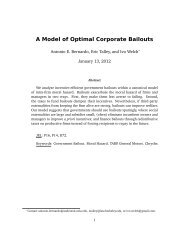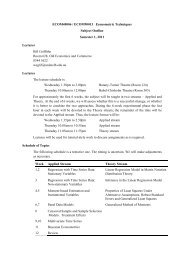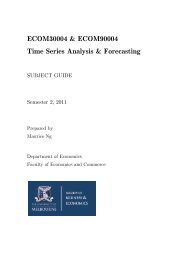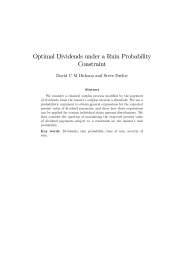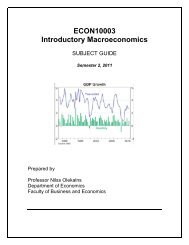Bayesian Inference in the Seemingly Unrelated Regressions Model
Bayesian Inference in the Seemingly Unrelated Regressions Model
Bayesian Inference in the Seemingly Unrelated Regressions Model
You also want an ePaper? Increase the reach of your titles
YUMPU automatically turns print PDFs into web optimized ePapers that Google loves.
19<br />
[ A] = [ y −h ( X, β)][ ′ y − h ( X, β )]<br />
(34)<br />
ij i i j j<br />
The jo<strong>in</strong>t posterior pdf for ( β, Σ ) is<br />
− ( T+ M+ 1) 2 1 −1<br />
2<br />
f( βΣ , | y) ∝f( β) Σ exp{ − tr( AΣ )}<br />
(35)<br />
and, <strong>in</strong>tegrat<strong>in</strong>g out Σ , <strong>the</strong> marg<strong>in</strong>al posterior pdf for β is<br />
2<br />
f( β| y) ∝ f( β ) A −T<br />
(36)<br />
Thus, <strong>the</strong> posterior for β <strong>in</strong> <strong>the</strong> nonl<strong>in</strong>ear SUR model <strong>in</strong>volves <strong>the</strong> same determ<strong>in</strong>ant<br />
of sums of squares and cross products of residuals as it does <strong>in</strong> <strong>the</strong> l<strong>in</strong>ear model. A<br />
more general prior has been added. (Of course, it also could have been <strong>in</strong>cluded <strong>in</strong><br />
<strong>the</strong> l<strong>in</strong>ear model.)<br />
The Metropolis-Hast<strong>in</strong>gs algorithm described <strong>in</strong> Section III can be readily<br />
applied to <strong>the</strong> posterior pdf <strong>in</strong> equation (36). Because <strong>the</strong> earlier results on conditional<br />
posterior pdfs for β and <strong>the</strong> β i no longer hold, <strong>the</strong> draws need to be used directly to<br />
estimate posterior pdfs and <strong>the</strong>ir moments.<br />
V. IMPOSING LINEAR EQUALITY RESTRICTIONS<br />
Economic applications of SUR models frequently <strong>in</strong>volve l<strong>in</strong>ear restrictions on <strong>the</strong><br />
coefficients. For example, <strong>the</strong> same coefficient may appear <strong>in</strong> more than one equation,<br />
<strong>the</strong> Slutsky symmetry conditions <strong>in</strong> demand models lead to cross-equation<br />
restrictions, or one might want to hypo<strong>the</strong>size that all equations have <strong>the</strong> same<br />
coefficient vector. Under <strong>the</strong> existence of cross-equation l<strong>in</strong>ear restrictions, <strong>the</strong> Gibbs<br />
sampler us<strong>in</strong>g β and Σ , and <strong>the</strong> Metropolis-Hast<strong>in</strong>gs algorithm, can still be used.<br />
However, <strong>the</strong> Gibbs sampler <strong>in</strong>volv<strong>in</strong>g only β is no longer applicable. If <strong>the</strong><br />
restrictions are all with<strong>in</strong> equation restrictions, all three algorithms are possible.



